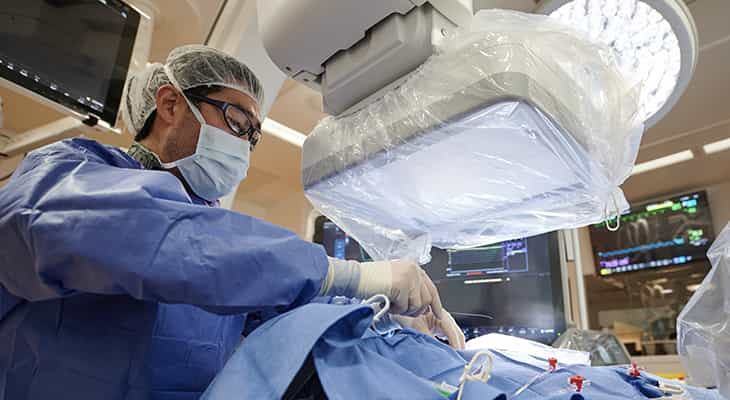Interventional cardiologists go up the leg vessels into the heart, insert the Piccolo device through the aortic or pulmonary artery, and repair the PDA.

Until recently, patent ductus arteriosus (PDA) repair in premature infants in the neonatal intensive care unit (NICU) required an involved surgical procedure. The surgeon would enter from the side, collapse the lung, find and ligate the vessels, reinflate the lung, and close. The patient usually required significant support for the next two to three days until recovery.
Outpatient cardiac catheterization to repair PDA works well for older infants and children, but the size of the devices to close the PDA were too large for the smallest premature babies. This could lead to compression on other structures in the chest.
A new medical device, specifically designed for PDA occlusion in micro-preemies, has given us an exciting new option for the tiniest babies. The Food and Drug Administration approved the Amplatzer Piccolo Occluder in 2019. We’ve used the Piccolo on neonates born as early as 24 weeks and weighing as little as 800 grams.
Refer a patient
To refer a patient to Norton Children’s Heart Institute, visit Norton EpicLink and choose EpicLink referral to Cardiology.
With this device, we’ve been able to repair PDA in very small infants and neonates using a minimally invasive procedure, rather than surgery. We can go up the leg vessels into the heart, insert the Piccolo device through the aortic or pulmonary artery, and occlude off the PDA. The Piccolo is smaller than a pea. If we need to, we can retrieve and redeploy the Piccolo for optimal placement.
About 12,000 premature babies in the U.S. are born each year with a very low birth weight and hemodynamically significant PDA, requiring treatment for the baby to survive.
Until the PDA is repaired, some of these micro-preemies can’t be extubated from mechanical ventilation, or they need continued significant respiratory support because of the extra pulmonary flow from the PDA. This extra flow increases their caloric demand as well as workload of the heart. Their caloric intake is not enough for them to grow well.
We all know mechanical ventilation is a double-edged sword because it increases risk of infection as well as causes trauma and damage to the lungs in premature infants.
Our goal is to minimize ventilation time and get these neonates extubated as quickly as we can. Using the Piccolo device at Norton Children’s Hospital, we’ve found we can significantly wean down the respiratory support within 24 hours, which results in a much faster recovery.
Edward S. Kim, M.D., is a pediatric cardiologist at Norton Children’s Heart Institute, affiliated with the UofL School of Medicine, and medical director of the cardiac catheterization labs at Norton Children’s Hospital.

